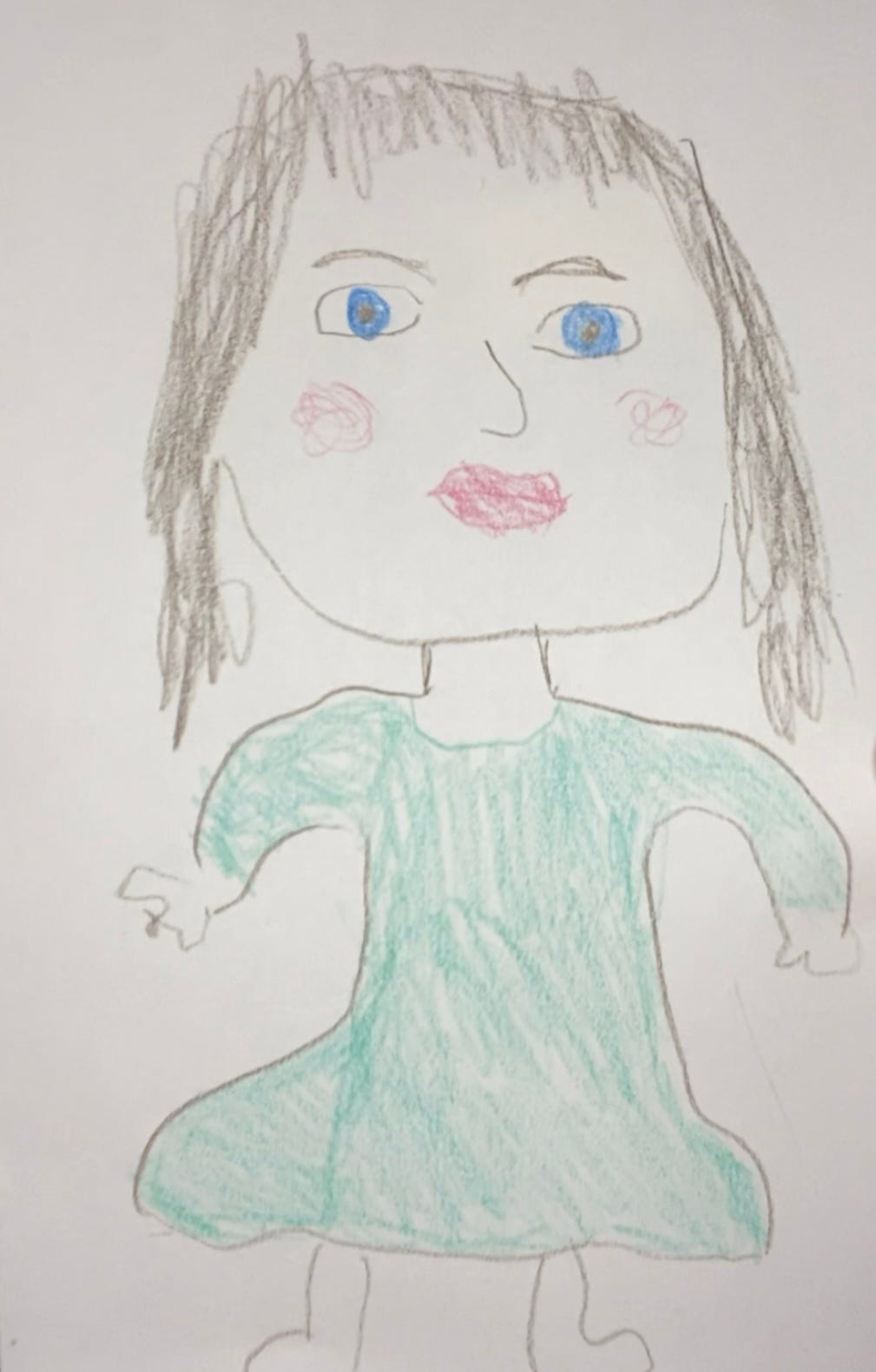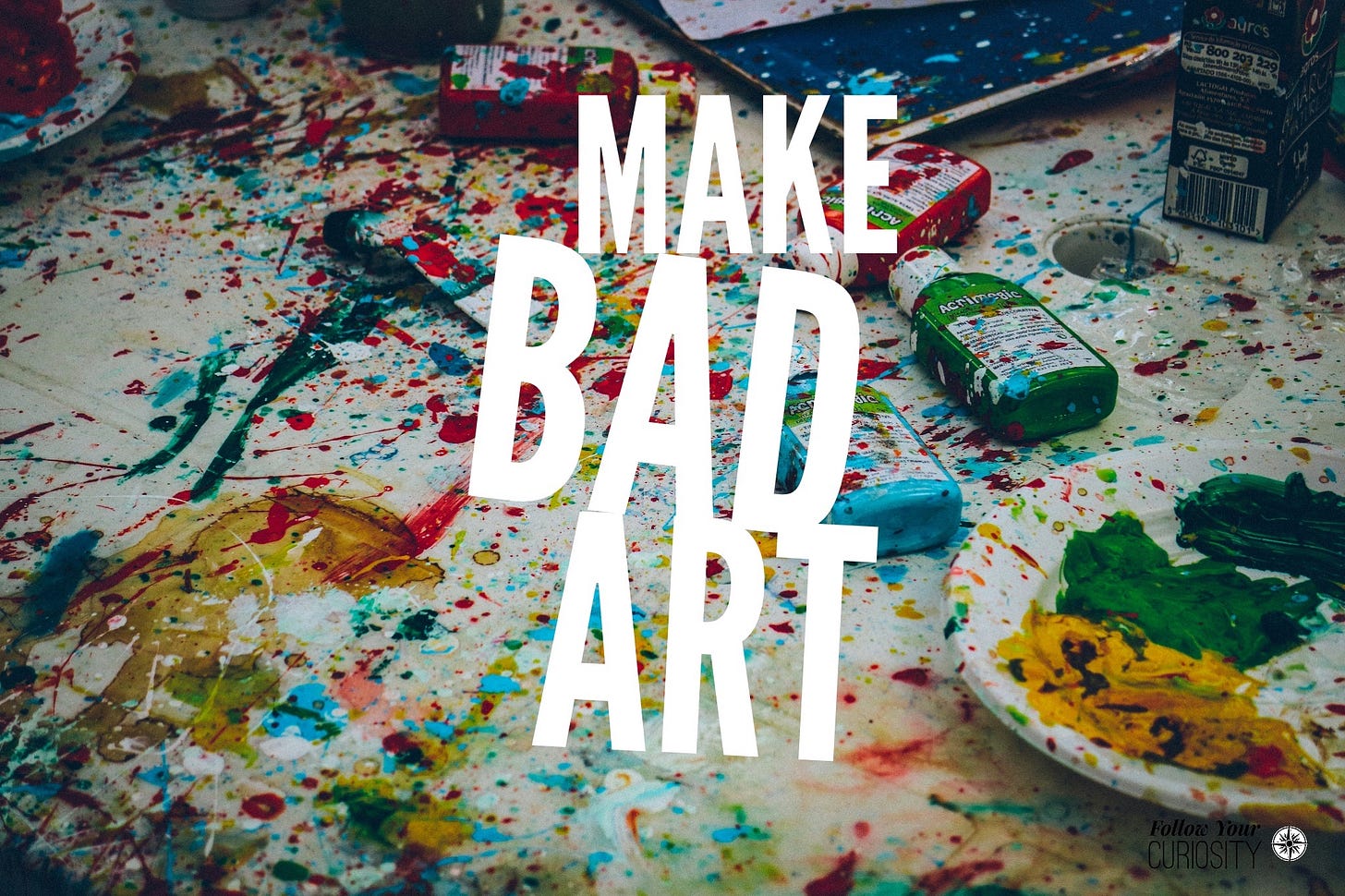Make Bad Art
It's okay. Better than okay. I promise!
I’m sure you took one look at that headline and thought something like, “Good lord, she’s finally lost her mind. What on earth is she thinking?”
Why would you want to make bad art when you could make good art? Everyone loves good art! And why wouldn’t you aspire to make good art? Isn’t that what aspirations are all about?
Even Neil Gaiman encouraged new graduates to make good art in a famous speech in 2012. (Watch it. No, really. Do it now. It’s short.)
I mean, who am I to argue with Neil Gaiman?
I’m not going to argue with Neil Gaiman. Why? Because he’s not wrong.
Okay, I can see you tearing your hair out now—I just said to make bad art!!—so let me explain.
Of course you should make good art. Good art is wonderful, and I would never tell you not to make it, not to dream of it, not to admire it.
What I would tell you is this: You can’t make good art until you make bad art.
Think about it: when you were a little kid, did you make good art? Be honest. Did you?
I sure didn’t. Heck, I don’t now, at least if we’re talking visual art. When I was teaching, I drew bad stick figures to illustrate things that required illustration, and I preceded them with, “All righty, everyone ready for some more of Miss Norbeck’s bad stick figures? Let’s go!”
They were, no kidding, the highlight of many of my classes, because we all got a good laugh out of them.
My brother—the architect—got the good drawing genes. On an extraordinarily good day I might roughly approximate something that might be mistaken for an xkcd comic. Maybe.
That’s okay, because I’m the writer in the family. We’re both musicians. It all evens out, in its way. But here’s the thing about both of us: neither of us was born knowing how to do any of these things. Is it possible that we each have some inborn quality that lends itself toward being better at art or stringing words together, or music? Sure, though that’s difficult to prove.
What I do know is that both of us were taught how to do what we do. And that means that both of us started out producing some really bad stuff, because there’s literally no other way to learn. You have to do bad work so you can learn from it in order to do better work. Practicing, by making bad art, is how you refine the skills that allow you to make good art.
That’s it. That’s all there is to it. That’s how learning works, and how good art happens—eventually.
The problem is that we forget that that’s how learning works, and that learning is a lifelong process. We accidentally, and unknowingly, internalize the idea that only good art matters. We get this idea, in part, by seeing the work of professionals without ever seeing the work they put in behind the scenes. As a result, we think we should—and can—only create good art, and that bad art is a sign that we’ve failed. That we didn’t do what we should have done. That we have no business making art of any kind because we’re not good enough. That we are bad artists, or even bad people. That we should just forget about making art at all and should perhaps consider making widgets instead. If that.
Then we wonder how we end up stuck, or lapsed, or both. We wonder how we lost our creative spark, and where and why our joy disappeared.
It’s the dual curse of perfectionism and its flip side: high expectations. Those’ll doom you every single time if you let them.
Two years ago, I did an exercise where I was supposed to draw a picture of myself with my non-dominant hand. I read this exercise with great trepidation for all the reasons listed above. I’m just not a visual artist on my best day, so I expected…nothing. A bad stick figure at the absolute best. Much more likely a tangled web of meaningless scribbles made by a group of drunken spiders.
This is what I got:
I was astonished. Surprised—pleasantly so, but truly baffled. Sure, it looks like something drawn by a grade-school kid, but that’s far, far beyond my wildest dreams for something drawn with my left hand (possibly also far better than something I’d have expected if I’d drawn it with my right, honestly). How the heck….?
My creativity coach brain finally kicked in the next day: because I was drawing left-handed, I had even lower expectations for myself than usual, if indeed I had any at all. Illusions of perfection were completely gone. I was free to do far better than I expected because nothing was pressuring me to do otherwise.
It made perfect sense. I was free to make bad art, and in the process, made incredibly good art for someone who has very little drawing ability/skill to begin with and was working with her non-dominant hand, to boot.
The fact that my right brain was in charge, because my left hand was doing the work, putting my more analytical left brain on the back burner, was probably also a factor.
I should be clear here that if I took a class for complete beginners, I could probably learn to draw at a better level than I do now, as could most of us where most skills are concerned. That actually gets back to my original point: we have to start with bad art to get to good art. The only alternative is to make no art, and who wants that?
And, hey—making bad art taught me that my bad left-handed art is actually much better than I thought it could possibly be!
But even when you’ve learned to make good art, it’s worth going back and making bad art every so often to break the spell of thinking that:
only “good” art is worthwhile
“perfect” exists
you have to be “good enough” to create
it’s a good idea to compare yourself to anyone else (including yourself!)
that “good” and “bad” art even mean anything much in the first place
Making bad art frees up your creative spirit and puts you back in touch with the child artist inside you, who knows that play is the key to everything worthwhile in this universe.
There’s no better place to make bad art than in the company of other people who are also making bad art, so I cordially invite you to gather up your favorite art supplies, pen, paper, notebooks, watercolors, crayons, glue, collage materials—whatever you like to experiment with—and hop on Zoom with me to make it official.
You have two opportunities to join us:
Sunday, June 9 at 1 pm Eastern (New York) time
or
Saturday, June 15 at 4 pm Eastern (New York) time
I’ve set these sessions at two hours to give us a little more time to share on screen (not just in the chat), but we may not need that full time depending on how many people join and how chatty we’re feeling that day. Plan for at least 90 minutes, though.
I hope you’ll come and give yourself permission to make bad art with us. Remember, as we say in Kaizen-Muse, anything worth doing is worth doing badly. 😁
P.S.:
About six years ago, after I’d introduced my nephews to the Pink Panther, the five-year-old was trying to draw the character. On his second try he did far better than I could ever hope do, but I decided to take a stab at a stick figure Pink Panther, as seen below:
I was actually quite impressed with my effort, but I swear I am not kidding when I tell you that the then-3-year-old took one look, pointed his Crayola marker at me, and declared, “No! Do it again! The feet are wrong!”
There is just no pleasing some people. 🤣
When have you made bad art? What happened? What did you learn? Tell us about it below!





